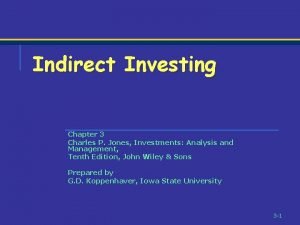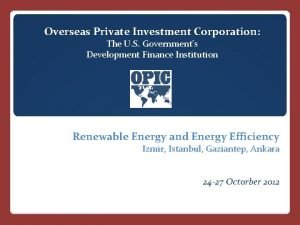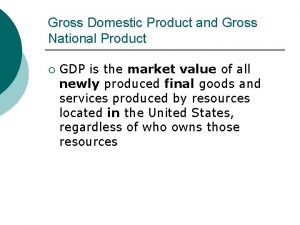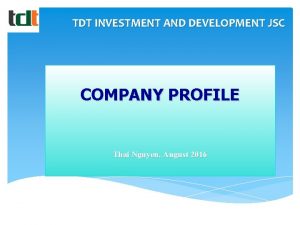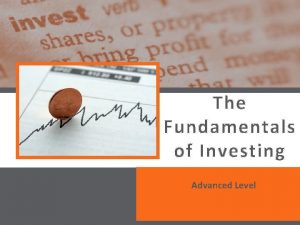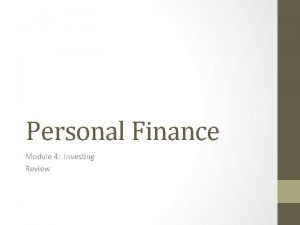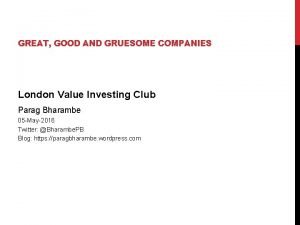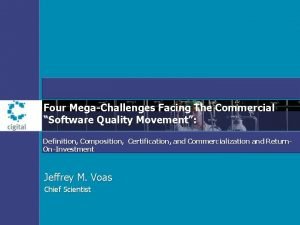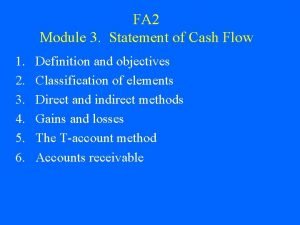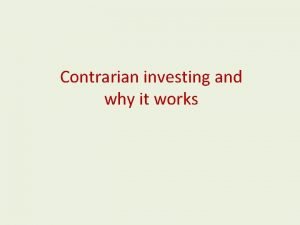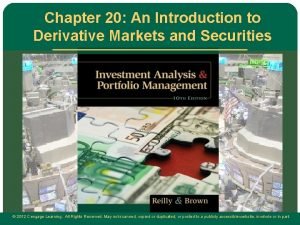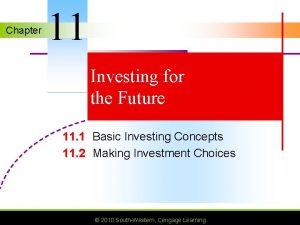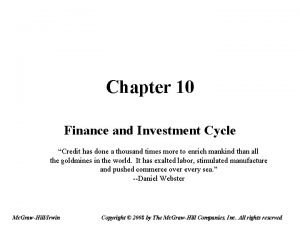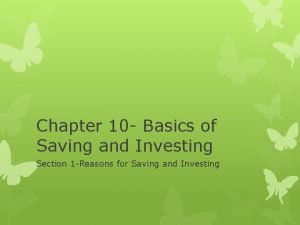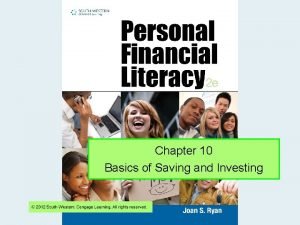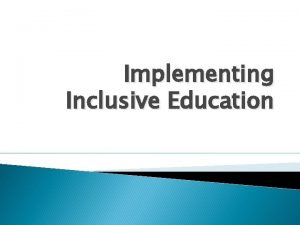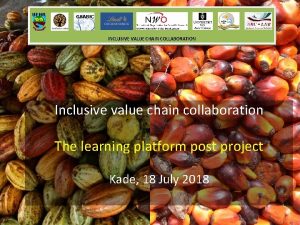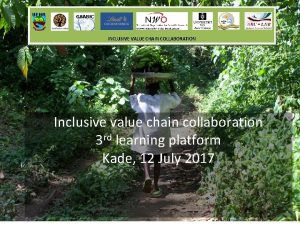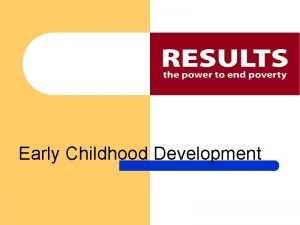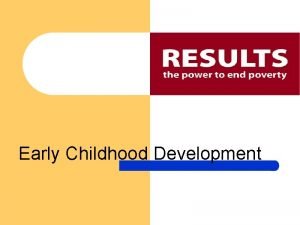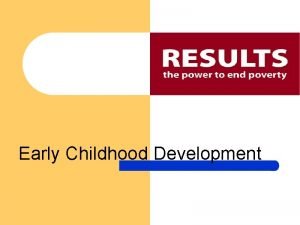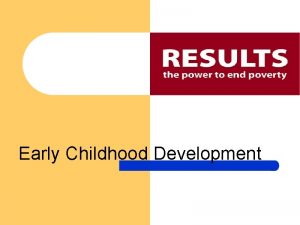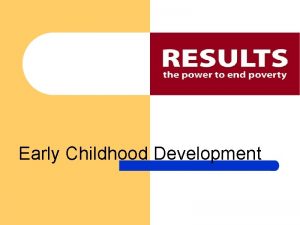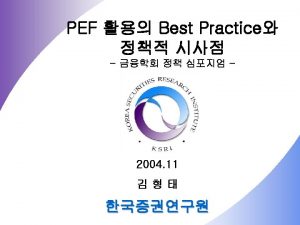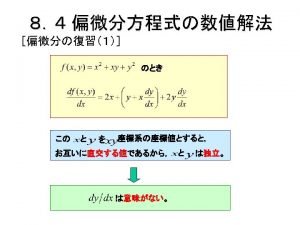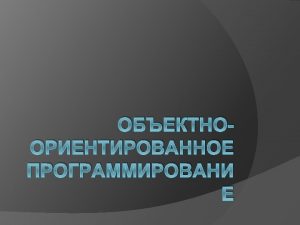Investing for development Supporting private investment for inclusive





















- Slides: 21

Investing for development: Supporting private investment for inclusive and sustainable agriculture-led economic growth Panelists: Carlijn Nouwen, Dalberg Advisors Afua Sarkodie, Dalberg Advisors CJ Fonzi, Dalberg Advisors John Bazley, Dalberg Advisors Moderator: Janet Lawson, USAID Bureau for Food Security Date: March 5, 2020

Afua Sarkodie, Dalberg Advisors As a Partner at Dalberg (based in New York) and current Team Leader for USAID’s Investment Support Program (ISP), a $60 M five year framework contract, Afua has led numerous engagements focused on developing partnership strategies, assessing partnership best practices, and M&E for different partnership initiatives across the public, private and philanthropic sectors. With an 18 year career she brings a wealth of experience working with private sector partnerships and investment mobilization in the agriculture sector to achieve development goals.

Carlijn Nouwen, Dalberg Advisors Carlijn Nouwen is a Partner in Dalberg’s Johannesburg office. Carlijn is the global lead for Dalberg Advisors’ Inclusive Business Growth Expertise practice; working in particular on innovative finance and investment. She often works for private sector clients on market selection and market entry strategy to turn inclusive business into a lasting competitive advantage. She has worked with USAID’s ISP to conduct multiple projects assessing sector and crop viability in Malawi, Rwanda, Niger, and Liberia, as well as development and delivery of training around business models, business opportunities and investment opportunities.

CJ Fonzi, Dalberg Advisors CJ Fonzi is a Partner and the Director of Dalberg’s Kigali Office. His experience spans a broad range of development issues including impact investing, agriculture, and SME finance and support. He has worked with public and private sector investors, bi- and multi- lateral donors, nonprofits, and multinational companies. CJ has deep expertise in Agriculture commercialization, including supporting USAID ISP to assess commercialization potential and specific export potential in eight value chains in Rwanda and support Rwanda’s National Agriculture Export Board and Rwanda Development board to actively promote investment in these areas.

John Bazley, Dalberg Advisors John Bazley is a Project Manager in Dalberg’s Washington DC office. He has worked with private corporations, NGOs, and foundations on strategy development, investment support, economic analysis, and business model development. His focus is on agriculture, impact investing, inclusive business models, and financial inclusion. He recently worked with USAID and Kf. W to identify ways to fund private sector innovators addressing malnutrition in SSA through a results-based, challenge fund approach, and has worked with USAID in assisting an investor with additional due diligence regarding the funding and development of a manufacturing facility for AD syringes in SADC.

Introduction Primers Insights

Investment Support Program Commercial investment by the private sector is a core driver of economic growth and development. The Investment Support Program (ISP) is a five year Bureau for Food Security (BFS)-led program (implemented by Dalberg Advisors) that identifies investment opportunities, mobilizes private capital, and deepens private and financial sector engagement. Through ISP, Missions have undertaken ~100 investment support activities, primarily in the agriculture sector. These range from value chain assessments and market analyses to sector mapping and other activities resulting in policy change, identification of investment opportunities, and strengthened capacity of Missions and host government agencies to facilitate investment for development impact.

Today’s objectives • Showcase a series of primers that have been developed to support USAID and its partners in facilitating private sector investment for inclusive and sustainable agriculture-led economic growth • Share our approach to investment opportunity identification and facilitation • Highlight key lessons drawing on the experience of ISP

Introduction Primers Insights

Primers The set of primers seeks to illustrate the steps in ISP’s investment support process across three main areas: 1 Identifying sectors/products with potential for commercialscale investment Technical steps 2 Enabling environment Mapping and addressing barriers that limit investment 3 Relationship building Engaging investors and investees around prioritized opportunities

Methodology Each primer is informed by the rich portfolio of ISP engagements… Non-exhaustive listing of relevant engagements … and targeted interviews with DC and Mission staff that have engaged with ISP repeatedly

Introduction Primers Insights

Example from Rwanda Opportunity Four value chains presented a viable business case for commercial investment Horticulture export to Europe was an opportunity due to: i) Growing demand in Europe for high-quality fresh produce ii) Difficulties in the Kenyan horticulture market in meeting minimum residue levels due to over-application of chemicals iii) Expansion of the national airline, bringing new direct routes from Kigali to Europe at affordable/subsidized prices What does it take to identify commercial investment opportunities for development impact?

Primer 1: Identifying Sectors / Products with Potential for Commercial-Scale Investment filtering process 1. 1 Generating a long list of products • Define the end objective – Increasing domestic consumption, promoting regional exports, or promoting intercontinental exports • Generate a long list of value chains or products – Selecting both “usual suspects” and “wild cards”, products that are “archetypes” for other products, and accounting for viability of production 1. 2 Shortlisting high potential products • Identifying potential deal-breakers – Viable products need to have commercial impact potential (compete for customers and investment capital) and social impact potential (compete for other productive resources and have thematic impact). Distilling business 1. 3 models and business cases around shortlisted products • Identifying business models for investment – metrics around growth and profitability potential, start-up considerations, specific binding constraints, and social and environmental indicators • Developing business cases around viable business models – Viability, profitability, competitiveness, incrementality

Primer 1 Guiding principles Take a business approach to honestly evaluating the competitiveness of products/value chains. A source of demand must be identified for the selected product/value chain It is entirely possible to move into new products/value chains. Conversely, just because something exists is not a rationale for expansion It is highly unlikely that organic, fair trade or “made in…” niche segments are sufficiently viable if the “basic” segment is not Focus on explicitly identifying and addressing only the most pressing binding constraints. Be mindful of potential unintended negative externalities

Primer 2: Mapping and addressing barriers that limit investment Supporting the investment filtering process Key considerations Scan the policy landscape 2. 1 around the opportunity • Understanding the current enabling environment context, the degree of clarity and predictability, and the ways in which the policy framework affects investors 2. 2 Identify key binding constraints • Policy, Social, and Technological barriers 2. 3 Set recommendations to enhance investments • Partnerships, Skills gap support, and Policies 2. 4 Help policy implementation NOTE: Steps above need not occur in succession and do not map to the stages of the investment filtering process. They apply differently in different scenarios and contexts • Convening of relevant forums to socialize recommendations, preparation of specific tools and presentation of supporting evidence for the recommendations

Primer 2 Guiding principles Do not try to be comprehensive in the problems you seek to solve Leverage local and national strategies, and use an investment opportunity as an avenue to drive progress Be specific about the solution you aim to deliver A highly tactical approach may be needed Facilitate early, close and dedicated stakeholder engagement. Understand the context before designing the intervention

Primer 3: Engaging Investors and Investees around Prioritized Opportunities Investment filtering process Map out key private investors and 3. 1 investees Key considerations • Identifying local implementers/operators, global implementers/operators and investors as well as types and terms of financing sought. Prioritize investors that are most 3. 2 aligned with USAID’s mission and • Consider the investment thesis and expansion strategy objectives Reach out to prioritized investors • Develop an engagement strategy, present tailored 3. 3 and investees to pitch multiple pitch materials investment opportunities 3. 4 Offer post-investment support NOTE: This primer covers the mechanics of engaging investors and investees at the end of the investment support process from Primer 1 • Engage regularly and convene private sector actors in thematic “private sector desks”

Primer 3 Guiding principles Private sector actors massively vary in type, context and approach Early, close and dedicated stakeholder engagement is critical Engagement and facilitation are needed, even for “warm” investors Establishing a shared big-picture vision for the partnership at the outset is crucial Overall partnership success can be enhanced by being purposeful about leveraging each partner's unique contributions and using USAID’s unique ability to broker relationships


 Direct investing vs indirect investing
Direct investing vs indirect investing Fixed investment and inventory investment
Fixed investment and inventory investment Overseas private investment corp
Overseas private investment corp Demand-pull inflation occurs when
Demand-pull inflation occurs when Investment phase of project development cycle
Investment phase of project development cycle Tdt investment and development joint stock company
Tdt investment and development joint stock company The statement of cash flows helps users
The statement of cash flows helps users Fundamentals of investment notes
Fundamentals of investment notes The basic rule of a risk-to-return relationship is that
The basic rule of a risk-to-return relationship is that Option trading definition
Option trading definition Lesson twelve saving and investing
Lesson twelve saving and investing Aswath damodaran value investing
Aswath damodaran value investing Great good gruesome
Great good gruesome Jeopardy smart
Jeopardy smart Investing in megachallenges
Investing in megachallenges Cash flow 1 2 3
Cash flow 1 2 3 Define contrarian investing
Define contrarian investing Derivative in investing
Derivative in investing Put and take account
Put and take account Financing and investing cycle
Financing and investing cycle Chapter 10 basics of saving and investing
Chapter 10 basics of saving and investing Holding a variety of investments to reduce risk
Holding a variety of investments to reduce risk
